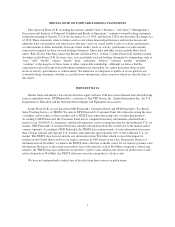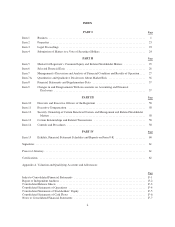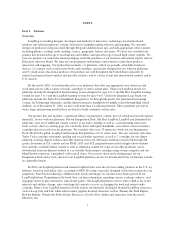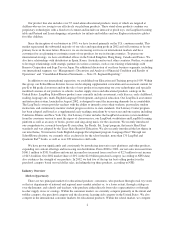LeapFrog 2002 Annual Report Download - page 13
Download and view the complete annual report
Please find page 13 of the 2002 LeapFrog annual report below. You can navigate through the pages in the report by either clicking on the pages listed below, or by using the keyword search tool below to find specific information within the annual report.helps us design our products in accordance with established standards of scope and sequence of learning,
appropriate for each target age group.
The following four educational principles are at the core of our products:
Children Learn Best When Actively Engaged
Our products encourage active participation by asking children questions and requiring them to direct their
own play before continuing with an activity. For example, children using our LeapPad interactive books can
control the information they receive by deciding what to touch with the NearTouch stylus. Even our Learning
Drum, designed for infants, engages them by only continuing with the activity or game after receiving a response
from the child.
Positive Reinforcement and Immediate Feedback Encourage Continued Effort
Our educational products are designed to help develop self-confidence through immediate and supportive
feedback. Many of our products offer clues that are designed to help lead a child to the correct answer, while at
the same time providing information on incorrect responses. For example, if a child is asked to locate Spain on
our Explorer interactive globe and touches France, the globe will respond, “You found France!” and then provide
a clue as to how the child can locate Spain. We believe this combination of presenting new information and
offering positive reinforcement encourages the child to continue learning.
Ability-Appropriate Tasks Motivate Learners
We believe that learning is most effective when a task matches the learner’s ability. For instance, a task that
is too easy may quickly become boring while a task that is too difficult may be discouraging and demoralizing.
To address this issue, we offer six age-appropriate platforms and a variety of content for each of these platforms
to address the specific needs of children as their skills develop and interests mature. Through our Learning
Center shelf displays and our LeapFrog newsletter, we provide guidance to parents on how to select the
appropriate product and content for each child’s age and ability. We have also developed products that adapt to
the user’s abilities. For example, we have designed our Turbo Twist handhelds to deliver easier or more difficult
questions based on a child’s performance. We believe this technology enables the child to spend more time
within his or her optimal learning zone.
Supplemental Materials Should Complement and Enhance What Children Learn at School
We design our products and content to be consistent with the curricula used in schools across the United
States. For example, with our Mind Station connector and a subscription to our Never-Ending Learning Club, at
the end of 2002, users of our iQuest handheld were able to download more than 7,000 chapter outlines and test
questions corresponding to over 200 textbooks currently used in U.S. middle schools. With the guidance of the
educational experts in our SchoolHouse division, we also design our products in accordance with state and
federal standards regarding the scope and sequence of learning.
We believe these educational principles are fundamental building blocks on which our company is built. We
implement these principles by leveraging our team of in-house educational experts and our outside Education
Advisory Board, which consists of seven distinguished educators. The members of our Education Advisory
Board actively participate in the design and development of our products by meeting with our creative design
team several times each year. Our Education Advisory Board also is an external source of feedback for our
creative design team with respect to new products that are in the development stage. We believe that both our in-
house experts and outside advisors are critical in the creation of our learning products.
8
























